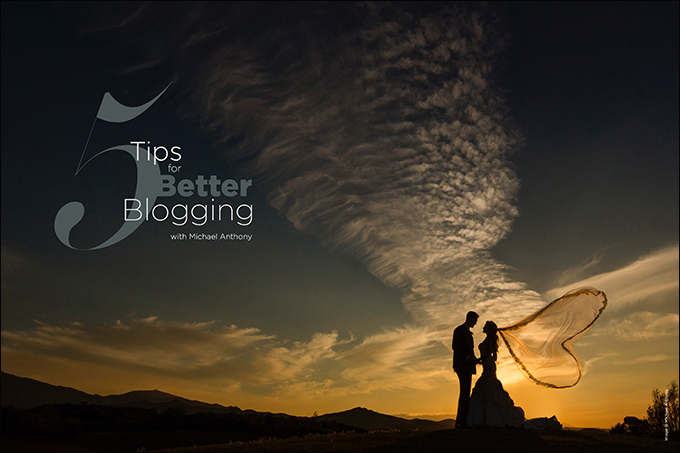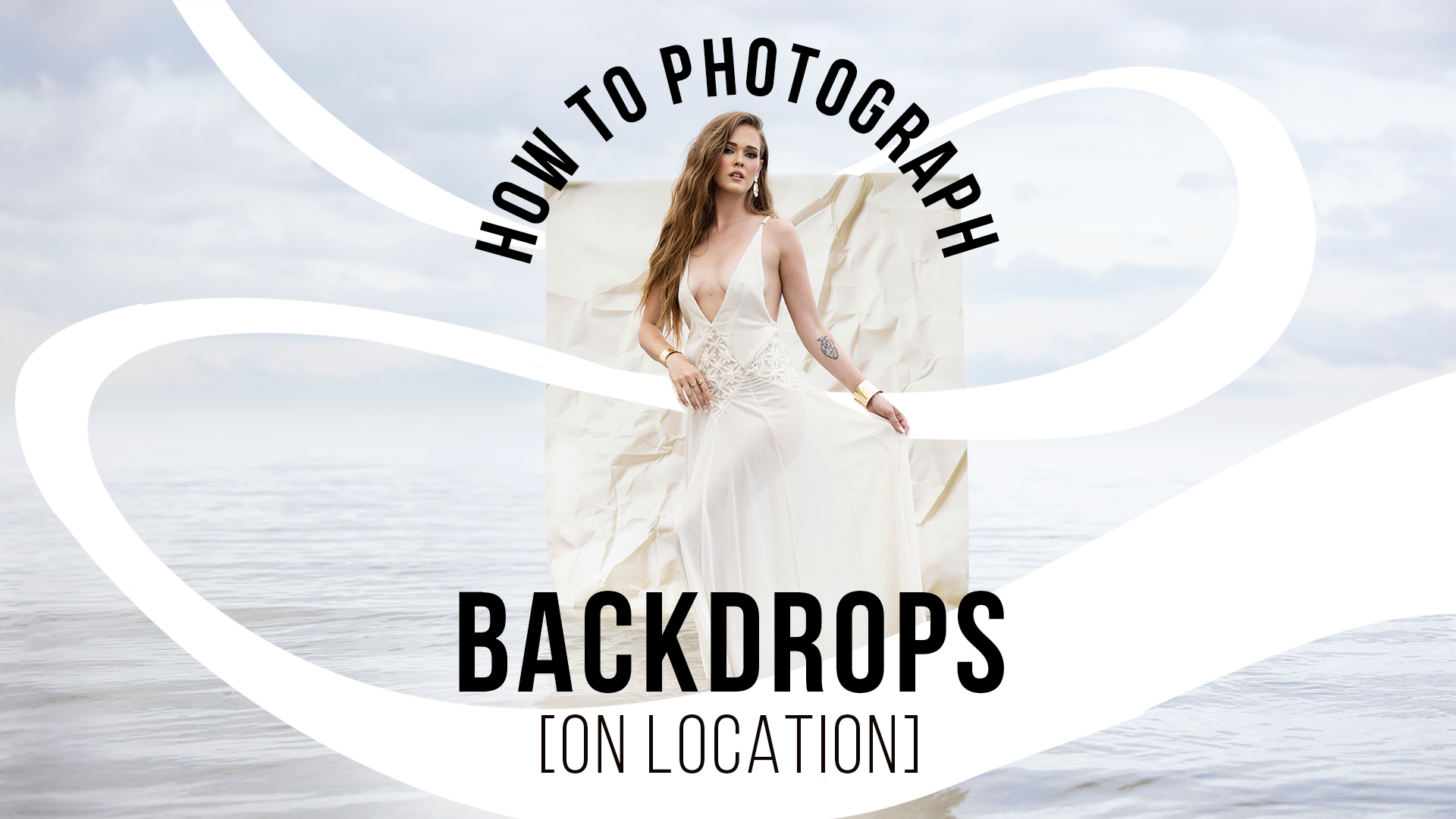5 Tips for Better Blogging with Michael Anthony
As business owners, we have many decisions to make when marketing to new clients. We need to weigh the benefits and drawbacks to certain avenues before deciding to invest in them. This can include both paid and free methods of advertising. Today, I want to talk about one of the most effective and basic forms of marketing available to pro photographers: blogging.
For an image-oriented business, blogging is one of the most simple and effective forms of marketing available. It allows us to showcase our latest work to potential clients, to communicate our ability to provide consistent results from shoot to shoot, rather than just a few good portfolio images on our website.
Here are a few things you can do to make sure you’re making the best use of this free marketing resource.
TIP 1: Focus on good text content for SEO purposes.
This should be the first thing you take into consideration when creating a blog post. The structure of your post should be engaging to viewers, but also to search engines—first and foremost, to Google, where text is king. Not just any text, but quality text that will be engaging to your website’s viewers. Google also cares about how you structure your posts, and it pays attention to content that you tell it is important. Your post title tells a search engine what your post is about, so structure your title with keyword-rich phrases that relate to the content of your post. Use appropriate heading tags (h1, h2, etc.) to tell search engines what to prioritize in your article.
While good SEO can attract potential clients searching for a key phrase (such as “los angeles wedding photographer”), search terms are very competitive and may not be obtainable in the short term due to a number of factors that are beyond our control. Instead, focus on being found via keywords that are less competitive but that still relate to your ideal clientele. Focusing on venues has been extremely successful for us in finding clients who are searching for images of weddings that took place at specific venues.
In your main content, focus on using more keyword-rich phrases, without overusing your keywords. Your content should sound normal when you read it aloud, since overusing particular keywords can earn you a penalty from Google. In addition, do not reuse content from post to post, or from elsewhere on the Internet. Google hates duplicate content and may penalize you if you are copying and pasting verbiage. Use a good plugin such as Yoast to make sure your blog post meets the minimum criteria for good search engine optimization.
TIP 2: Take time to focus on the metadata in your images.
Metadata is often overlooked by photographers. Lightroom allows us to easily alter metadata in an image. I am not going to sugarcoat it: This is the most consuming part of blogging, but it is the most necessary in order to get good results in the search engines.
In the library tab in Lightroom, scroll down to the Metadata module. From there, click the dropdown menu just left of Metadata and select Default. The next section goes into detail about many of the fields that will appear. After you change the metadata in your Lightroom catalog, don’t forget to highlight all of the images you changed, and then choose Metadata > Save Metadata to File.
Filename
The filename you choose matters. We usually title all of the images in a blog post the same way, sequentially (“Hyatt-Valenica-Wedding-Pictures-1,” for example). Whatever you choose, make sure it’s relevant to the blog post, and use hyphens to separate the words since this filename will become part of the URL of the image when posting online. SEO experts recommend you use a different filename for each image. While this may be best for SEO, it is very time consuming.
Title
This is what Google reads alongside the filename to give your image context. Choose a separate title for each image. Remember, Google does not like duplicate content, and if you choose the same title for each image, Google will likely pick one to index, rather than all of them for different search terms. The problem is that you will not have a choice as to which one is indexed. In a wedding post, I create titles like “Groom with his mother and father before ceremony at Wayfarers Chapel” or “Bride putting on veil at Hyatt Huntington Beach.” Google associates words such as bride and groom with wedding, so don’t obsess about constantly using the same words in your titles.
Caption
Google loves text, and the caption is where Google wants to see the details about what is going on in your photograph. Good practice is to write 100 to 300 words in your caption for each image. I know it’s time consuming, but it helps get your images indexed in search engines. Use keyword-rich (not spammy) text when describing what is going on in your photograph.
Sublocation
Matt Cutts, head of Google’s web spam team, announced in February 2014 that Google may use location information along with other metadata embedded in your image to influence search engine ranking. I usually include the location of the venue I am shooting at in the metadata of my images if it is a location people would be using in a search engine query.
TIP 3: Your blog is not for your current client, but for your next client.
Way too often when I look at photographer blogs, I see some amazing images, but then I see some that actually detract from the body of work in a post. Early in my own career, I thought it was prudent to tell the whole story of a wedding day in a blog post. I would include 60 to 70 images of things like close-ups of hands during the cake cutting, or the groom placing the ring on the bride’s finger.
Are these important moments? Sure, but they are not going to influence the next person looking at my blog to hire our studio. Instead, use only images that you feel show what is unique about your style of photography. Our style is unique, but we still take traditional photos on the day of the wedding. You just won’t see these images on our blog because they do not showcase what is different about our style.
Give the images you are blogging the same attention that you would if the client chose them for their wedding album. These images need to be more than just color-corrected, and should show your skill in lighting, composition and retouching. Keep the mindset that the images you show are designed to attract your next ideal client.
TIP 4: Use the power of social media to attract clients to your blog.
Many photographers are eager to get images posted on social media to reach potential referrals. By sending images straight to Facebook, though, you are not taking advantage of the search engine optimization benefits you get from getting extra traffic to your blog. When clients are eager to share their images, they will happily take a link that you send them and share that rather than just images from a social media page.
That link will get people to your website, increase your website traffic and get potential clients right where they need to be to see the rest of what you offer. Remember to put a contact form at the bottom of your blog post. If you are using WordPress, NinjaForms is a great plugin that allows you to do this. Squarespace allows you to add a form at the end of a post as well.
Remember, for this to be effective, an event or shoot has to still be on people’s minds. If you are a wedding photographer, blog the images within 72 hours. In 2016, my goal for our main Michael Anthony Photography brand is to get a wedding blogged no later than the Monday after a Saturday wedding so I can market it Tuesday to vendors and the client’s social network.
Tip 5: Your blog can be the most effective form of follow-up you have for cold leads.
We have spent a good portion of time talking about the SEO benefits of blogging, but in addition to good SEO, blogging is great for organic marketing as well. Every time we put up a new blog post, we send out an email campaign to our list that is constantly updated with new leads. These leads now have the opportunity to reconnect with our business, and I can’t tell you how many times this has turned an otherwise cold lead into a signed contract. It is our most effective form of follow-up, going well beyond a random follow-up email because it’s indirect and reminds clients why they initially connected with you.
While there are many forms of marketing, the blog still remains one of the most important tools we have. If your blog is stale, update it at least once a week to ensure you are providing potential clients fresh, up-to-date content. If you need to, set up some styled shoots for fresh images just for your blog.
While blogging may seem time-consuming, with persistence and consistency, you will see results from incorporating it into your marketing plan.




